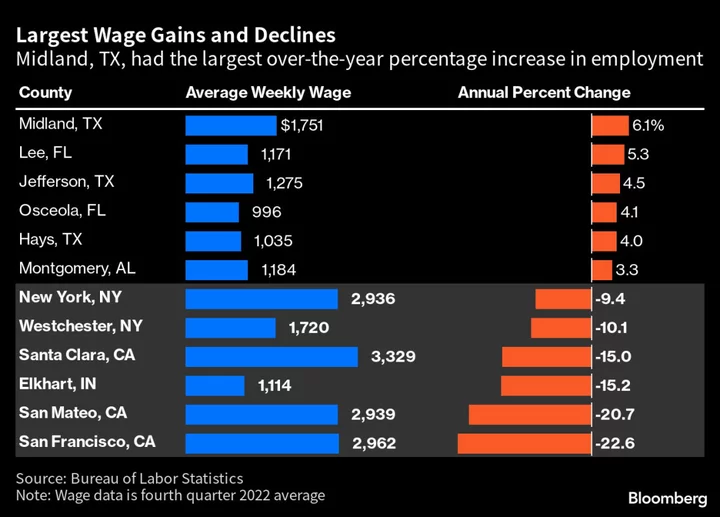US weekly wages fell in 2022, according to new Bureau of Labor Statistics figures, revealing widespread softness that wasn’t previously evident in other data.
Average weekly wages were $1,385 in the fourth quarter of last year, a rare 2.3% decline from the same period in 2021, the latest results from the Quarterly Census of Employment and Wages, published Wednesday, showed. The 2022 drop followed a 5.9% increase the year before.
The QCEW figures differ from other government measures of wages in that they include things like bonuses, stock options and severance pay. They’re also used to revise more timely, high-frequency measures like those included in the monthly jobs report published by the BLS.
Last year’s drop probably reflects smaller incentive pay amid a softening in hiring trends, according to Ron Hetrick, an economist at Lightcast. In 2021, companies in all kinds of industries were offering unusual perks to attract workers, as they scrambled to staff up again when the economy reopened after Covid lockdowns.
“Employers have pulled back on the bonuses that they’re offering as the labor market has cooled,” Hetrick said. “That includes everything from hiring bonuses to retention bonuses to inflation bonuses.”
The QCEW measure provides a different perspective on the state of the labor market than the average weekly earnings figures published in the monthly jobs report, which showed a 4.2% increase in 2022. The differences in the types of compensation included in each mean the two are not directly comparable.
It also played a role in the weak figures on gross domestic income published Thursday, with wages and salaries “now estimated to have increased $53.0 billion in the fourth quarter, a downward revision of $135.4 billion” after accounting for the QCEW data, the Bureau of Economic Analysis said.
Wage decreases were relatively widespread across the US, according to the QCEW data, with 240 of the largest 355 counties seeing declines.
The report also contained several clues that a shift in the composition of the workforce — with higher-paying industries shedding jobs while hiring in lower-paying industries remained robust — helped put downward pressure on overall wages.
San Francisco, for example, registered a 22.6% drop in average weekly wages, the biggest decline among the 355 largest counties, as professional and business services wages fell 24.9%. New York County saw wages fall 9.4%, with a 14.9% pay decline in finance.
“We are seeing that demand for workers is slowing down in tech and in other white-collar sectors, while it still remains a hot labor market for some of these other industries like food services and healthcare,” said Daniel Zhao, an economist at Glassdoor.
One bright spot was Midland, Texas, which saw average weekly wages rise 6.1%, the biggest increase among the 355 largest counties. The natural resources and mining sector in Midland registered a 3.3% wage increase.
A surge in oil prices in 2022 spurred increased drilling activity in and around Midland, which sits atop the country’s largest oil basin. Energy companies have scrambled to find workers, boosting pay and helping drive down the area’s unemployment rate.
Read More: Texas Town With Biggest US Pay Raise Keeps Powell on Hiking Path
The QCEW also contained new information on employment. It showed a 2.6% increase in headcount across the country in 2022, about half a percentage point lower than the employment growth registered in monthly jobs reports.
Gains were concentrated in the South, with Midland seeing the biggest rise in headcount, up 7.9%. Other counties in Texas and in Florida rounded out the top five.
Elkhart, Indiana — known as the world’s recreational vehicle manufacturing capital — and Hendricks, Indiana, saw the largest decreases in employment, with headcount down 1.7% in each county.
--With assistance from Catarina Saraiva.
(Adds details on GDI impact in seventh paragraph.)

